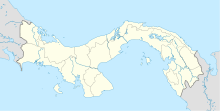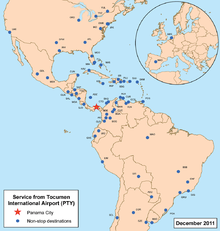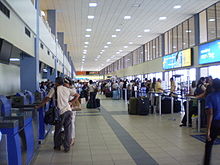- Tocumen International Airport
-
Tocumen International Airport
Aeropuerto Internacional de TocumenIATA: PTY – ICAO: MPTO – FAA LID: PTY Summary Airport type Public Operator Tocumen S.A. Serves Panama City Location Tocumen, Panama Hub for Copa Airlines Elevation AMSL 41 m / 135 ft Coordinates 09°04′17″N 079°23′01″W / 9.07139°N 79.38361°WCoordinates: 09°04′17″N 079°23′01″W / 9.07139°N 79.38361°W Website Map Location in Panama Runways Direction Length Surface m ft 03R/21L 3,050 10,007 Concrete 03L/21R 2,682 8,799 Asphalt Statistics (2010) Passengers 5,042,410 Source: DAFIF[1] Tocumen International Airport (Spanish: Aeropuerto Internacional de Tocumen) (IATA: PTY, ICAO: MPTO) is an international airport located 15 mi (24 km) from Panama City, Panama. In 2006, it underwent a major expansion and renovation program in order to modernize and improve its facilities. It is currently the only airport in Central America with two runways for use and is also the largest airport in the country and the busiest in Central America by passenger traffic.
Contents
History
During World War II, Panamanian airports were leased exclusively by the U.S. military. The nearest airport to Tocumen was the Paitilla Point Airfield. Several airports were built to protect the Panama Canal from foreign aggression. The 37th Pursuit Group at Albrook Field replaced the P-40 Warhawks of the 28th Pursuit Squadron at the Paitilla Point airbase from 9 December 1941 though 26 March 1942 in the immediate aftermath of the Pearl Harbor attack.
The first Tocumen International Airport was inaugurated on June 1, 1947 by President Enrique A. Jiménez, and airport operations began before the construction works were completed.
The administrative building/passenger terminal was inaugurated seven years later, during the administration of Colonel Jose Antonio Remon Cantera. The old airport, which currently is being used as a cargo terminal, was built on an area of 720 ha (1,800 acres) and was 126 ft (38 m) above sea level. As time passed, and due to Panama's role as a country of transit, that terminal became too small to attend to the growing demand for air operations. This compelled the aeronautical authorities at the time to consider expanding the airport. Work on the new installations began in 1971.
In order to build the structure that currently houses the current passenger terminal, a lot of land had to be moved and the bed of the Tocumen river had to be diverted from its original site. The current passenger terminal was inaugurated on August 15, 1978 and operations began on September 5 of the same year. The Tocumen International Airport is one of the few airports in the region that has two landing runways able to serve the largest commercial aircraft operating today.
The name of the airport was changed in 1981 by the military government for Omar Torrijos International Airport, in honor to the Panamanian leader who died in July 31, 1981, at the age of 52 in a plane crash in Cerro Marta, Coclesito in very bad conditions. After nine years, the original name was reestablished after the fall of the dictatorship of Panama by the U.S. invasion of 1989.
The runway of the old airport is mainly used for cargo and private flights, but also as a supplement to the runway during peak traffic periods. The main runway is 3,050 × 45 m (10,007 × 148 ft) and is used primarily for commercial flights. Until May 31, 2003 Tocumen International Airport was managed by the Civil Aeronautics Directorate (which is known today as the Civil Aeronautics Authority). On June 1 of that year, an innovative terminal management platform was created through Law No. 23 of January 29, 2003, which set out a regulatory framework for the management of airports and landing strips in Panama. This law allowed the creation of Aeropuerto Internacional de Tocumen, S.A., also referred to as Tocumen, S.A., which currently manages the terminal. This law is one of a number of laws that restructured the aeronautical sector in Panama to further its improvement and modernization.[2]
Air traffic
Tocumen Internation Airport is a regional hub for commercial flights heading to and from The Caribbean, South America, North America and Central America. Also, the European cities of Frankfurt, Madrid and Amsterdam are served.
Tocumen International Airport is also the home airport of Copa Airlines.
Year Passengers % Change Cargo % Change Movements % Change 2003 2,145,489 11.5% 85,508 - 43,980 - 2004 2,398,443 11.8% 96,215 12.5% 45,703 3.9% 2005 2,756,948 15% 103,132 19.6% 47,873 4.6% 2006 3,215,423 16.6% 82,186 -20.3% 53,853 12.7% 2007 3,805,312 18.3% 82,463 0.3% 61,400 14.0% 2008 4,549,170 19.5% 86,588.8 4.8% 73,621 19.9% 2009 4,748,621 4.4% 83,513 -3.8% 80,330 9.1% 2010 5,042,410 6.2% 98,565 18.0% 84,113 4.7% Busiest International Routes out of Tocumen International Airport (2008)[3] Rank City Passengers 1  Bogota, Colombia
Bogota, Colombia412,893 2  Miami, Florida
Miami, Florida379,891 3  San José de Costa Rica
San José de Costa Rica344,774 4  Caracas, Venezuela
Caracas, Venezuela229,267 5  Mexico City, Mexico
Mexico City, Mexico197,054 6  Guatemala City, Guatemala
Guatemala City, Guatemala183,060 7  Houston, Texas
Houston, Texas170,744 8  La Habana, Cuba
La Habana, Cuba160,468 9  Santo Domingo, Dominican Republic
Santo Domingo, Dominican Republic158,209 10  Medellin, Colombia
Medellin, Colombia136,637 11  Lima, Peru
Lima, Peru131,836 12  Buenos Aires, Argentina
Buenos Aires, Argentina126,419 13  Atlanta, Georgia
Atlanta, Georgia104,276 14  Maracaibo, Venezuela
Maracaibo, Venezuela104,045 15  Newark, New Jersey
Newark, New Jersey98,114 16  Quito, Ecuador
Quito, Ecuador96,903 Reference
- Tocumen International Airport Website
- Tocumen Airport Report 2004 Website
- Tocumen Airport Report 2006 Website
- Tocumen Airport Report 2007 Website
- Tocumen Airport Report 2008 Website
- Tocumen Airport Report 2009 Website
- Tocumen Airport Report 2010 Website
Airlines and destinations
Main terminal
Airlines Destinations Aeroperlas Bocas del Toro Air Transat Seasonal: Montréal-Trudeau, Toronto-Pearson, Winnipeg [begins December 21],Vancouver[4] American Airlines Miami
Seasonal: Dallas/Fort WorthAvianca Bogotá CanJet Charter: Montréal-Trudeau, Toronto-Pearson Condor Flugdienst Frankfurt, Santo Domingo Continental Airlines Houston-Intercontinental, Newark Copa Airlines Aruba, Asunción [begins December 15], Barranquilla, Belo Horizonte-Confins, Bogotá, Brasilia, Buenos Aires-Ezeiza, Cali, Cancún, Caracas, Cartagena de Indias, Chicago-O'Hare [begins December 15], Córdoba, Guadalajara, Guatemala City, Guayaquil, Havana, Kingston, Lima, Los Angeles, Managua, Manaus, Maracaibo, Medellín-Córdova, Mexico City, Miami, Montego Bay [begins December 11], Monterrey [begins December 16], Montevideo, Nassau, New York-JFK, Orlando, Port-au-Prince, Port of Spain, Porto Alegre, Punta Cana, Quito, Rio de Janeiro-Galeão, San Andrés Island, San José de Costa Rica, San Juan, San Pedro Sula, San Salvador, Santa Cruz de la Sierra-Viru Viru, Santiago de Chile, Santiago de los Caballeros, Santo Domingo de Guzmán, São Paulo-Guarulhos, St. Marteen, Tegucigalpa, Toronto-Pearson, Valencia (Venezuela), Washington-Dulles Copa Airlines Colombia Barranquilla, Bogotá, Bucaramanga, Cali, Cartagena de Indias, Cucuta [begins December 16], Guatemala City, Medellín-Córdova, Pereira, San José de Costa Rica Delta Air Lines Atlanta Dutch Antilles Express Curaçao Iberia Madrid KLM Amsterdam Lacsa Medellín-Córdova, San José de Costa Rica SBA Airlines Caracas Spirit Airlines Fort Lauderdale Sunwing Airlines Toronto-Pearson
Seasonal: Montréal-Trudeau[5]TACA Airlines San Salvador TAME Guayaquil, Quito Venezolana Caracas, Maracaibo Cargo airlines
Airlines Destinations ABSA Fortaleza, Guayaquil, Manaus, Miami, Quito. AeroSucre Cargolux Cielos del Perú DHL Aviation operated by DHL Aero Expreso FedEx Express LAN Cargo Líneas Aéreas Suramericanas TAB - Transportes Aéreos Bolivianos Miami, Santa Cruz de la Sierra-Viru Viru UPS Airlines Vensecar Internacional Expansion 1
The 2006 expansion and modernization project consisted of three stages:
Passenger terminal expansion
The main passenger terminal was expanded 20,830 m2 (224,200 sq ft) at a cost of approximately US$ 21 million. New boarding gates were built to allow more flights to and from Panama, and to facilitate the growth of commercial and internal circulation areas.
Tocumen airport administration acquired 22 new boarding bridges and replaced the oldest 14. This included the addition of 6 remote positions, hence allowing Tocumen Airport to have a total of 28 boarding gates. The new installations were opened in 2006. The airport also has two vip lounges, one United Club for Copa Airlines and Continental Airlines, and a Admirals Club for American Airlines.
Equipment
The next step of the modernization project was the purchasing of new equipment to provide service and support to the common areas of the airport.
New equipment included: modern boarding gates and elevators, luggage conveyor belts, flight information system, and revamping the air conditioning system.
Renovation in the cargo terminal
The renovation of the old Tocumen international airport (originally built in 1947) to be used solely as a cargo terminal, was the last step of the modernization project of Tocumen international airport. It included the redesign of the central building, the construction of new buildings for cargo companies among other improvements. [6]
Expansion 2
Muelle Norte
The second expansion phase of Tocumen International airport is known as Terminal Muelle Norte. At a cost of USD 60 million, a completely new terminal with 12 additional aircraft docking positions (gates) will be built. With these 12 new gates plus the existing 22 gates and the six remote aircraft docks, there will be a total of 40 gates.
The new facilities are going to include platforms, taxiways and a new road which will connect both the cargo terminal and the airport's administration building.
Muelle Norte will be linked to the main passenger terminal and will have 10 moving walkways for passengers and 1,400 m2 (15,000 sq ft) for commercial areas.
The luggage sorting system will be expanded to accommodate increased demand. Also, one gate designed to accommodate A380 aircraft will be built.
The tender for the design of the second phase was given to Ecuador-based Planman Cia Ltda. Colombia-based Aerotocumen won the tender of the construction of the Muelle Norte. The project started in mid-October 2009 and is projected to be completed in early 2011.
Capacity will increase from 5 million to 10 million passengers per year.
References
 This article incorporates public domain material from websites or documents of the Air Force Historical Research Agency.
This article incorporates public domain material from websites or documents of the Air Force Historical Research Agency.- ^ Airport information for MPTO at World Aero Data. Data current as of October 2006.Source: DAFIF.
- ^ "History of Tocumen Airport". Tocumen Airport Panama. http://www.tocumenpanama.aero/index.php?cccpage=historia. Retrieved 2010-08-01.
- ^ http://www.tocumenpanama.aero/upload/files/TOCUMEN_INFORME_ESTADISTICO_2008.pdf
- ^ http://www.airtransat.com/en/3_0.asp
- ^ http://www.sunwing.ca/Panama-Travel/Costa-Blanca-Vacation-Packages.asp
- ^ "Expansion Plan of Tocumen Airport". Tocumen Airport Panama. http://www.tocumenpanama.aero/index.php?cccpage=otros_proyectos. Retrieved 2010-08-01.
External links
- Tocumen International Airport Website
- Tocumen Airport aerial photo from Google Maps
- Tocumen Intl. on Virtual Aviation Info
- Second phase of expansion of the Tocumen International Airport(Spanish) 2008/04/24
- Tendering of the Muelle Norte (Spanish) 2008/06/25
 USAAF Sixth Air Force in World War IIPreviously: Panama Canal Air Force (1940-1941); Caribbean Air Force (1941-1942)
USAAF Sixth Air Force in World War IIPreviously: Panama Canal Air Force (1940-1941); Caribbean Air Force (1941-1942)Airfields Caribbean Coolidge (Antigua) · Dakota (Aruba) · Batista (Cuba) · Camaguey (Cuba) · Hato (Curacao) · Vernam (Jamaica) · Arecibo (Puerto Rico) · Borinquen (Puerto Rico) · Losey (Puerto Rico) · Benedict (Saint Croix) · Beane (Saint Lucia) · St. Thomas Airport (Saint Thomas) · Carlsen (Trinidad) · Piarco Airport (Trinidad) · Waller (Trinidad)Canal Zone Panama Central and South
America
Units Commands VI Bomber Command · VI Fighter Command · XXVI Fighter Command · XXXVI Fighter Command · VI Air Force Service · Antilles Air CommandGroups Fighter Bomber Reconnaissance Squadrons Categories:- Airfields of the United States Army Air Forces in Panama
- Airports in Panama
- Panama City
Wikimedia Foundation. 2010.




